
- Kenneth Walker III has been a top-12 fantasy running back when healthy: Walker has consistently started seasons strong from a fantasy perspective before injuries have kicked in.
- Klink Kubiak’s offense will help: Kubiak’s focus on zone run schemes, running the ball and throwing to running backs should help maximize Walker’s fantasy potential whenever he’s healthy.
- Subscribe to PFF+: Get access to player grades, PFF Premium Stats, fantasy football rankings, all of the PFF fantasy draft research tools and more!
Estimated Reading Time: 5 minutes

PFF’s Fantasy Football Player Profile series delivers the most in-depth fantasy football analysis available for the 2025 season.
Using PFF’s exclusive data, we evaluate player performance, competition for touches and how teammates and coaching staffs will impact each player’s fantasy football outlook.
Last updated: 7:15 a.m. Tuesday, May 14
Player performance
Kenneth Walker III was drafted with the 41st overall pick in the 2022 NFL Draft. After a month as a backup, Walker took over as the starter in Week 6, and he’s been the Seahawks’ primary starter ever since. Throughout Walker’s career, he’s had stretches of being a great fantasy back mixed with injuries.
Walker averaged 19.7 PPR points per game through his first six career starts then suffered an ankle sprain. He missed a week and was less effective in the game where he was injured and in the game he returned from injury, but he finished the season with three 100-yard performances. In 2023, he started the season with 17.4 points per game over the first six weeks, but then his snaps decreased significantly, which was followed by missing games with an injury. He never played 60% of Seattle’s offensive snaps again that season. In 2024, he similarly started strong with 22.3 fantasy points per game over his first five games, but injuries limited his quality of play and the number of games he played over the rest of the season.
Walker’s injuries, mixed with a bottom-10 offensive line, have made it difficult for him to play well with any kind of consistency, but he has shown sparks of a great running back. His 0.42 avoided tackles per attempt last season were the most in PFF’s 19 years of statistics for all running backs with at least 50 carries. The next-most with any player with at least 150 carries in a season was 0.31, which is a tie that includes 2014 Marshawn Lynch and 2020 Nick Chubb. Walker received a +1 graded run or better at the third-highest rate among running backs over the last two seasons, behind only Jahmyr Gibbs and Derrick Henry.
He was much more involved as a receiver last season than in his first two years, increasing both his routes per game and his targets per route. His PFF receiving grade over the last two seasons ranks ninth-best among running backs with at least 400 routes.
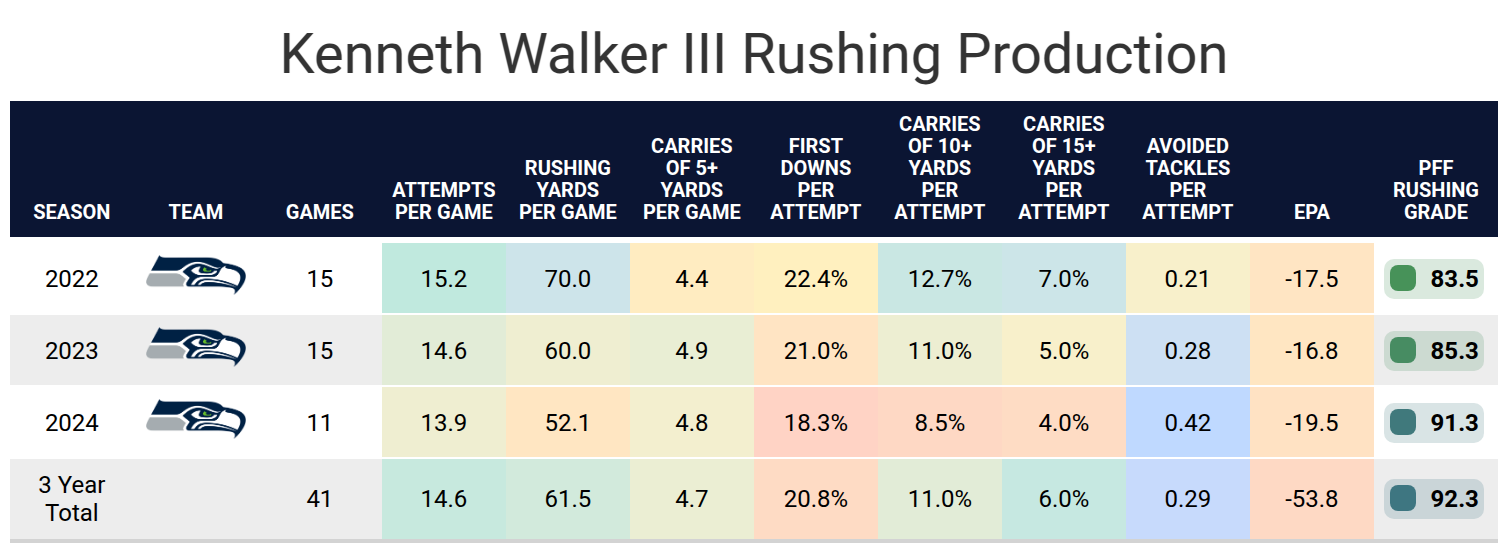
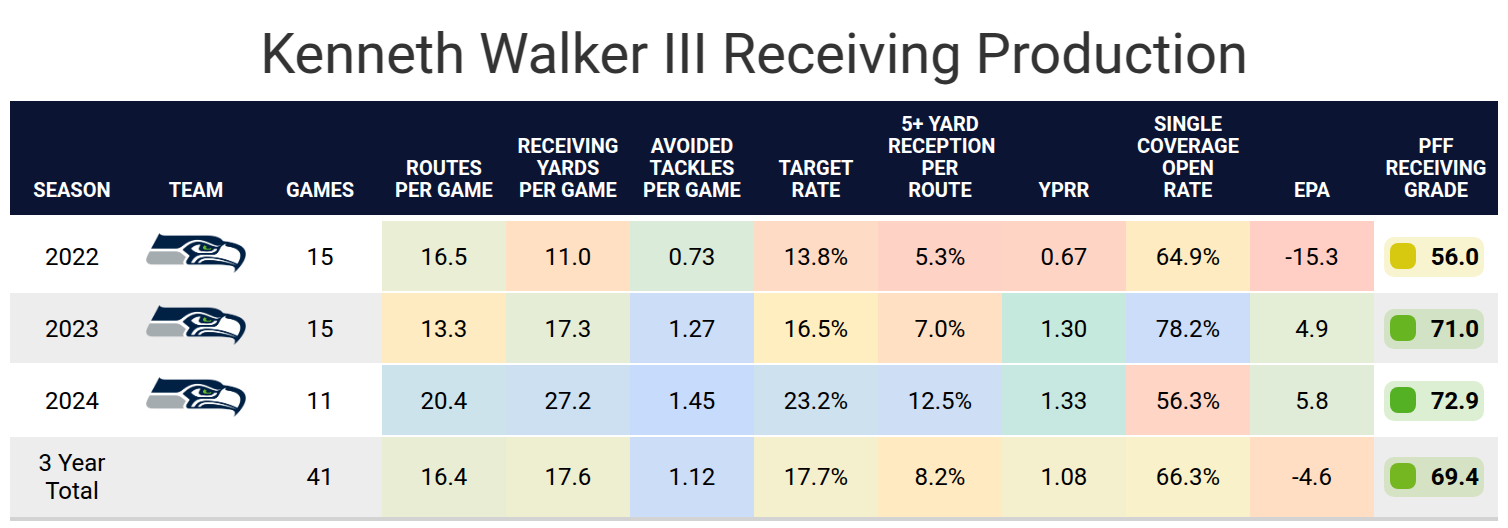
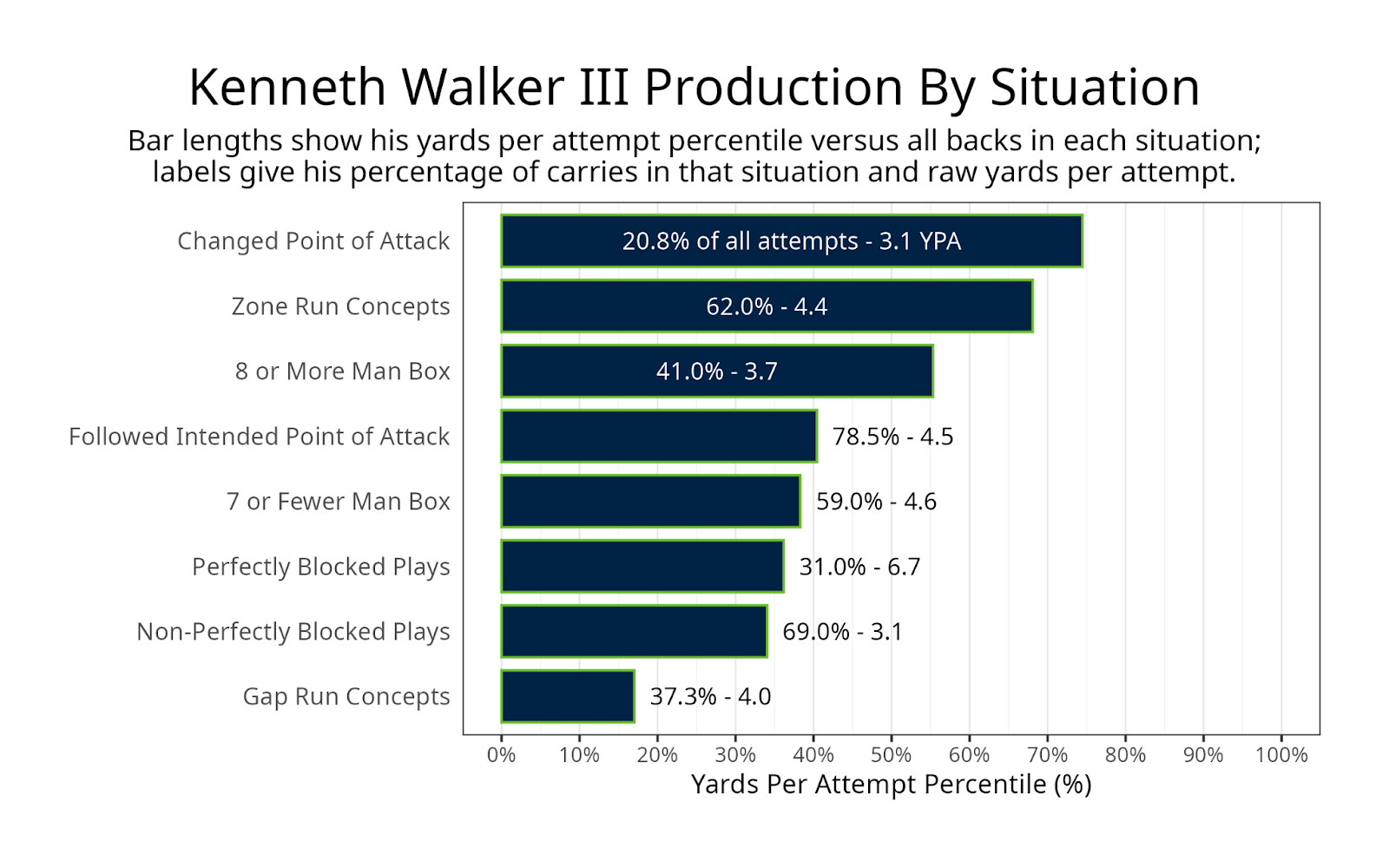
Projected role
Walker has shared the backfield with Zach Charbonnet for the last two seasons, and this one will be the third. Walker has generally played on early downs and short-yardage situations, while Charbonnet would play on third downs. A significant difference in 2024 compared to 2023 is that Walker was the primary running back during two-minute drills. Walker ended up leading the league in two-minute drill receptions by a running back at 15, leading to 92 yards. In 2023, he didn’t receive a third-down target.
The backfield will likely only be a two-man rotation, but Kenny McIntosh has been the third running back on the depth chart the last two seasons, and Seattle drafted Damien Martinez in the seventh round. The Seahawks have a new coaching staff, so there is at least a chance one of the two could also get involved.
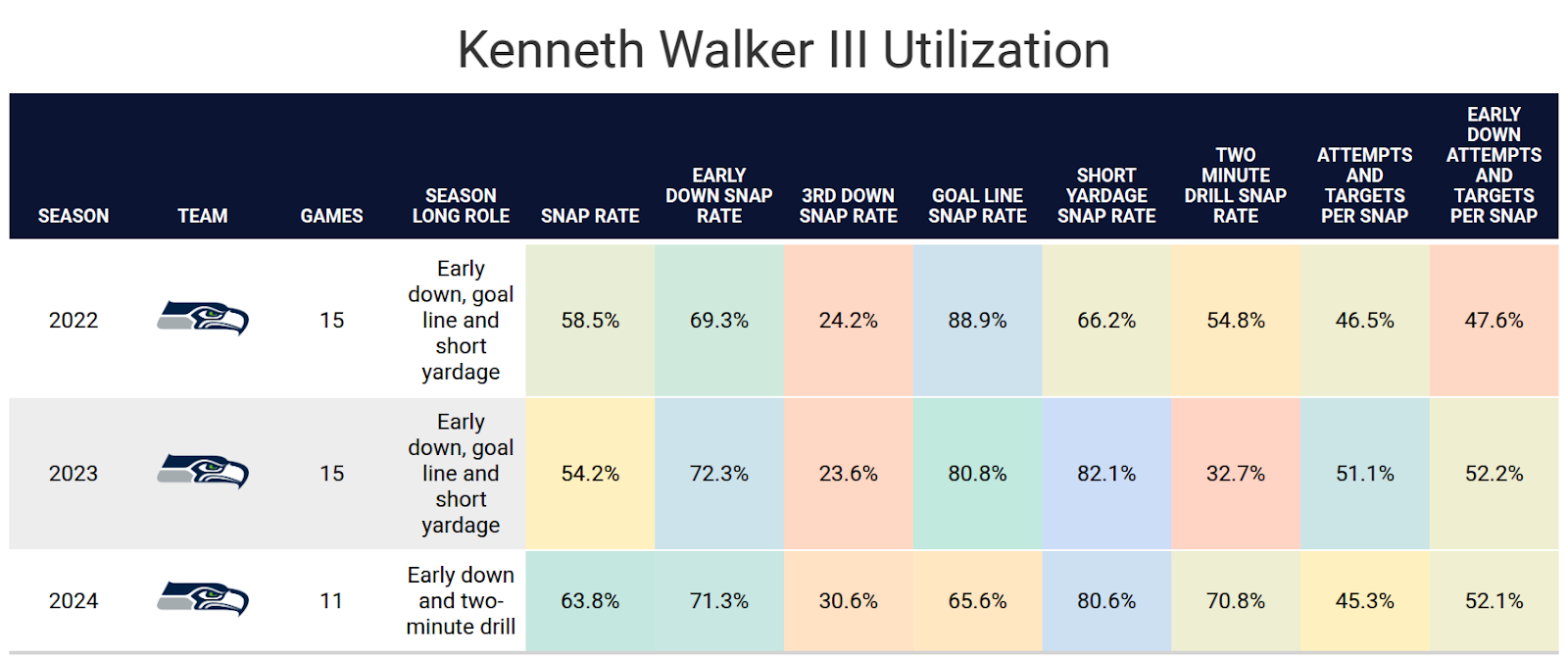
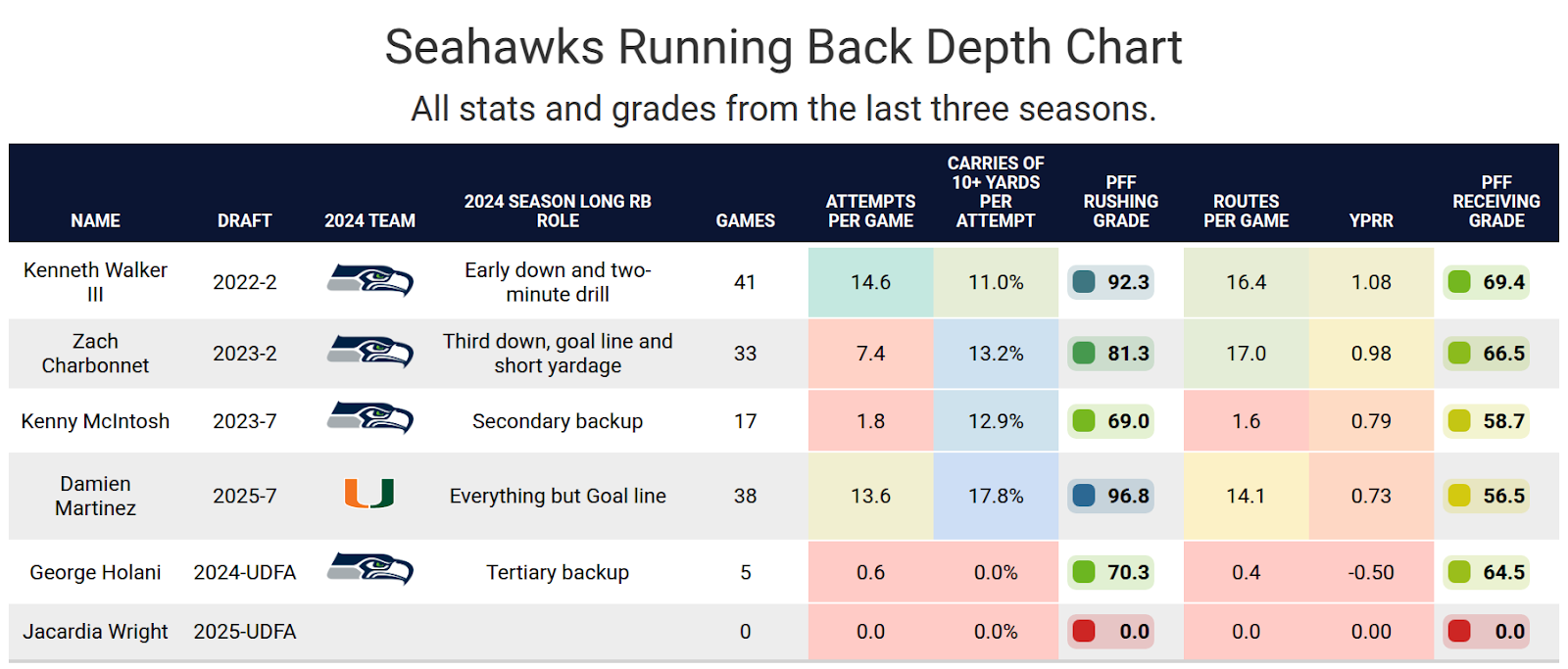
Impact of teammates
Klint Kubiak is the Seahawks’ new offensive coordinator. He has worked as an offensive or passing game coordinator on five different teams in the last five seasons. In three of the last four stops, including his last two as an offensive coordinator, his team has had a top-12 fantasy running back. This includes Alvin Kamara, who was fifth in fantasy points per game last season, and Christian McCaffrey, who was first in 2023. His offenses have consistently featured the running back in the passing game. Kubiak’s teams have ranked top seven in zone concept frequency at all four stops, and the Seahawks should primarily run zone concepts this season. They ran more gap concepts last season. Walker has played notably better on zone concepts than gap, so this change should also help Walker.
Kubiak mentioned multiple times in his initial press conference that it was important to focus on the run game, Walker was their best running back, and they would get him the ball any way they could. They’re also converting two tight ends into fullbacks, which will further add to an emphasis on the run game.
One consistent problem for Walker has been the Seahawks’ offensive line, which fell from an average offensive line in his first two years to a bottom-10 line last season. On the bright side, Charles Cross took a major step forward in 2024 with a 77.9 run-blocking grade and 81.3 pass-blocking grade, making him one of the best young left tackles in the league. The team also spent a first-round pick on Grey Zabel, who finished with an 86.4 run-blocking grade in his final season at North Dakota State. He’s expected to play guard for Seattle and should be an upgrade.
The other three spots will be held by recent mid-round draft picks. On the bright side, one reason the Seahawks were in the bottom 10 rather than average is due to injuries. Cross and former left guard Laken Tomlinson are the only offensive linemen on the team with 11 or more starts last season. The projected starters generally graded better than the backups. If this line can stay healthy, they should be close to average. Ideally, given their age, players generally improve to bring them to average or above average.
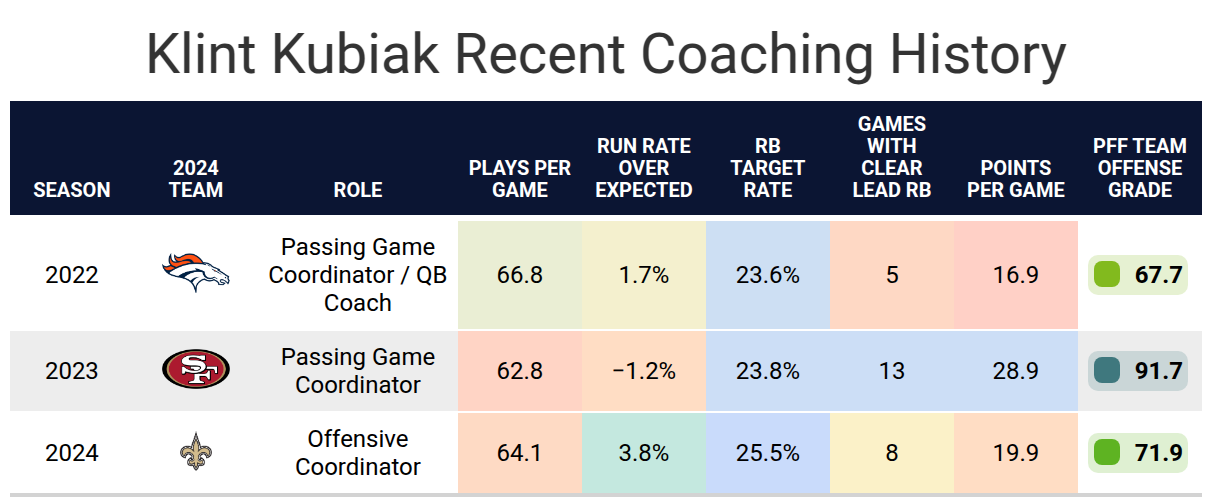
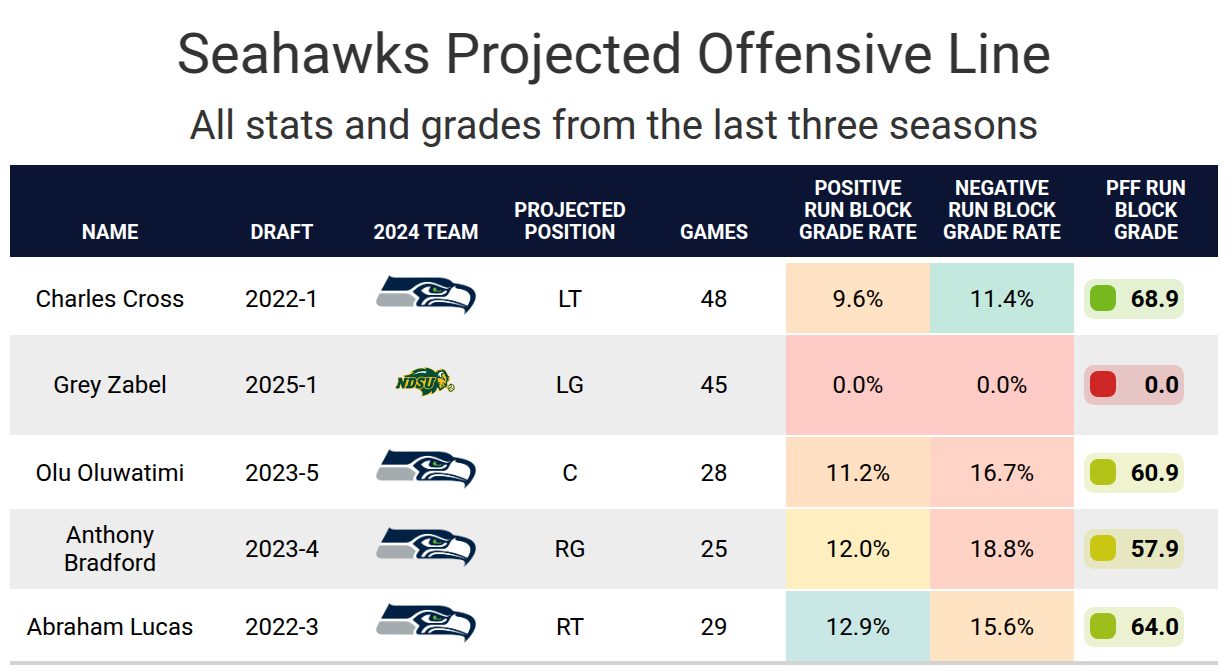
Bottom line
Walker finished 12th in fantasy points per game last season. His talent mixed with Klint Kubiak’s offensive scheme could move him into the top eight, but injuries and the offensive line have been a consistent problem in Walker’s career, which could continue this season.

Footnotes
- Statistics in tables and charts were chosen based on their ability to predict future fantasy performance on a per-game or per-opportunity basis or to describe the player relative to others at the same position.
- “Opportunities” are defined as passing dropbacks, rushing attempts and routes run as a receiver.
- Numbers are provided either by season or based on the past three years. For rookies, only college statistics are included. For non-rookies, only NFL statistics are considered, regardless of whether they played in college within the previous three years.
- As college competition is easier than NFL competition, most rookies are likely to see a decline from their historical numbers.
- Only FBS data is considered for college players and comparisons.
- Kneel-downs are removed from rushing data to provide cleaner quarterback rushing rate statistics.
- The table colors in this article range from blue (indicating good/high) to red (indicating bad/low).
- All percentiles and color codings compare the given player to others with a high sample of opportunities. Generally, the cutoff is one-third of the possible opportunities in the sample. If a player does not meet the threshold, they are still included in the comparison, though their results may appear better or worse than expected due to the smaller, less predictive sample size.
- Information on utilization classifications and their importance can be found here for running backs, wide receivers and tight ends.
This news was originally published on this post .





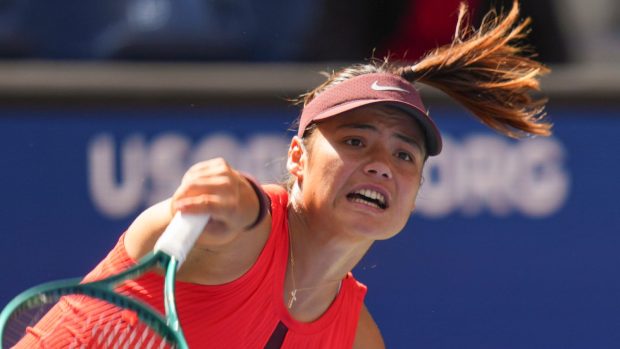



Be the first to leave a comment